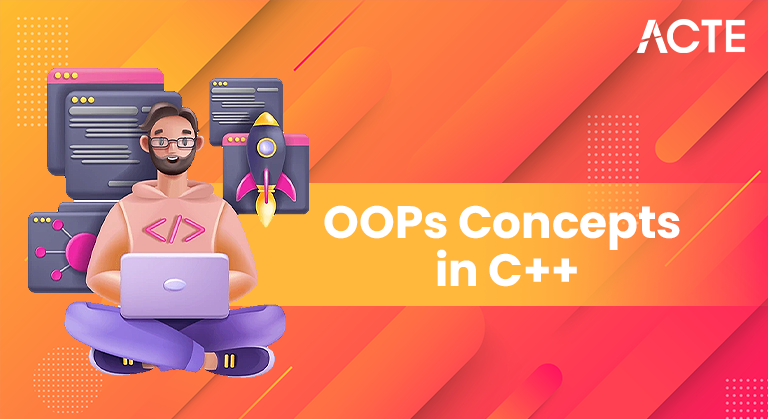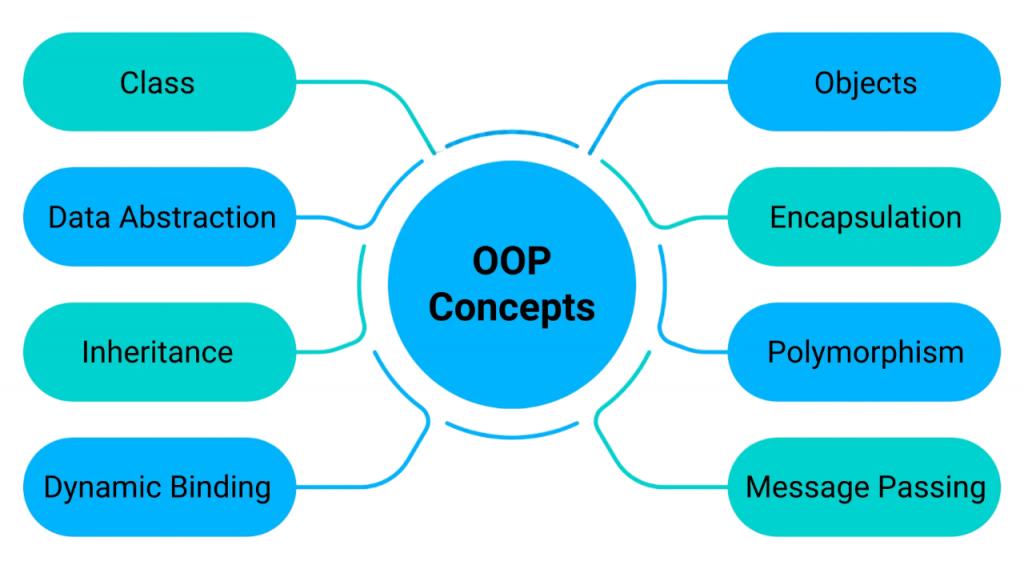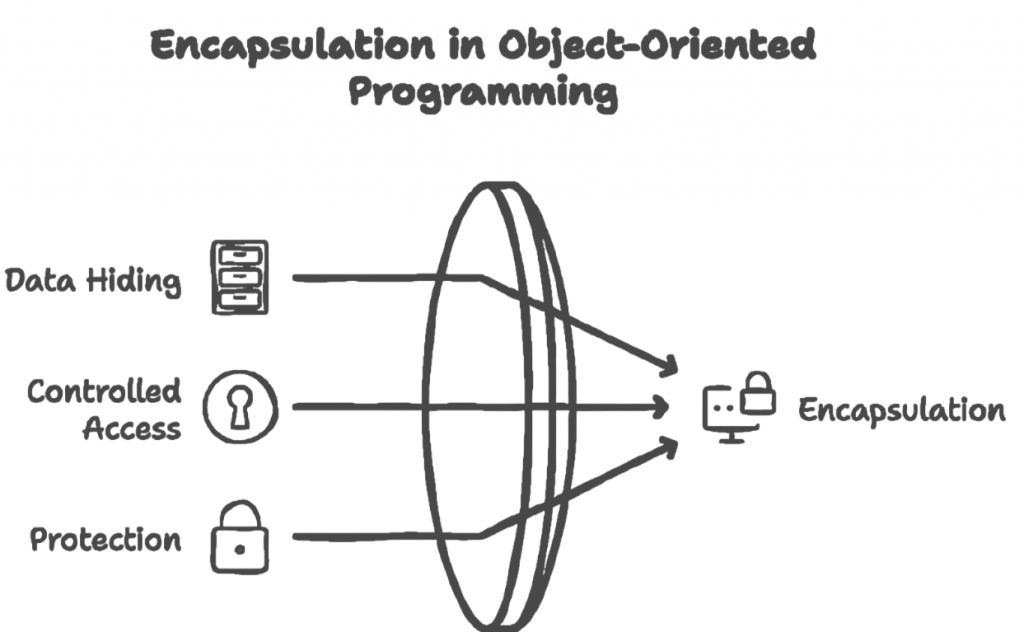
- Introduction to OOPs Concepts in C++
- Basic Principles of OOPs Concepts in C++
- Classes and Objects in C++
- Data Members and Member Functions
- Constructors and Destructors
- Inheritance and Its Types
- Polymorphism: Compile-Time and Runtime
- Function Overloading and Operator Overloading
- Virtual Functions and Abstract Classes
- Encapsulation and Data Hiding
- Friend Functions and Static Members
- Real-World Applications
- Best Practices in C++
- Conclusion
Introduction to OOPs Concepts in C++
Object-Oriented Programming (OOP) is a programming paradigm that focuses on using objects and classes to structure software. Instead of viewing a program as a sequence of procedures, OOP views it as a set of interacting objects that mirror real-world entities. OOPs concepts in C++ is one of the earliest and most powerful languages to support OOP. To complement such object-oriented principles with practical application development skills, exploring Web Developer Training equips learners to apply OOP fundamentals in JavaScript, TypeScript, and modern frameworks building modular, reusable components that reflect real-world logic in dynamic web environments. It extends C by introducing features like classes, inheritance, and polymorphism.
Benefits of Object-Oriented Programming (OOP):
- Modularity: Code is organized into logical units.
- Reusability: Classes and functions can be reused in other programs.
- Scalability: Easy to manage and extend large codebases.
- Maintainability: Encapsulation makes debugging and updating code easier.
To Earn Your Web Developer Certification, Gain Insights From Leading Web Developer Experts And Advance Your Career With ACTE’s Web Developer Courses Today!
Basic Principles of OOPs Concepts in C++
C++ supports four core principles of OOP: encapsulation, inheritance, polymorphism, and abstraction. To complement such foundational design concepts with efficient data handling and persistence, exploring Python Serialization reveals how Python enables seamless object storage and transmission using techniques like pickling, JSON encoding, and the shelve module to serialize complex data structures for reuse, sharing, or long-term storage.

- Encapsulation: Bundles data and methods within a single unit (a class) and restricts direct access to some of the object’s components.
- Abstraction: Hides internal details and shows only the essential features, helping reduce complexity.
- Inheritance: Enables a new class to inherit properties and behavior from an existing class, facilitating code reuse and extension.
- Polymorphism: Allows objects to be treated as instances of their parent class, enabling the same interface to perform different functionalities.
Classes and Objects in C++
A class is a user-defined data type that acts as a blueprint for creating objects. It encapsulates data members and member functions. To complement such object-oriented principles with platform-specific development capabilities, exploring What is .Net FrameWork reveals how Microsoft’s .NET platform supports robust application development offering tools, libraries, and runtime services for building secure, scalable desktop and web applications on Windows systems.
Syntax Example:
- class Car {
- public:
- string brand;
- void honk() {
- cout << “Beep!” << endl;
- }
- };
- // Object
- // An object is an instance of a class.
- Car myCar;
- myCar.brand = “Toyota”;
- myCar.honk();
To complement such object-oriented design principles with practical development skills, exploring Web Developer Training equips learners to apply class-based structures in JavaScript and modern frameworks enabling modular architecture, reusable components, and scalable web application development.
Would You Like to Know More About Web Developer? Sign Up For Our Web Developer Courses Now!
Data Members and Member Functions
Data members:
Variables defined inside a class.
Member functions:
Functions defined inside a class that operate on data members.
- class Employee {
- public:
- string name;
- int id;
- void display() {
- cout << name << ” ” << id << endl;
- }
- };
Access modifiers (public, private, protected) control visibility.
Constructors and Destructors
Constructor:
A special member function with the same name as the class, invoked automatically when an object is created. To complement such constructor-based initialization in object-oriented programming, exploring What is Quality Assurance reveals how systematic processes and standards ensure software reliability focusing not just on functionality, but also on performance, usability, and maintainability throughout the development lifecycle.
Types:
- Default Constructor
- Parameterized Constructor
- Copy Constructor
- class Box {
- public:
- int width;
- Box(int w) { width = w; }
- };
Destructor
- ~Box() {
- cout << “Destructor called!”;
- }
A special member function, preceded by ~, called automatically when an object goes out of scope.
Are You Interested in Learning More About Web Developer? Sign Up For Our Web Developer Courses Today!
Inheritance and Its Types
Inheritance promotes code reuse by allowing a class to inherit from another class. To complement such object-oriented design principles with performance validation techniques, exploring What is Spike Testing reveals how this testing method evaluates system behavior under sudden, extreme load conditions ensuring that inherited functionalities and integrated components remain stable and responsive during unpredictable traffic surges.
Syntax:
- class Parent {
- public:
- void greet() { cout << “Hello”; }
- };
- class Child : public Parent {
- // inherits greet()
- };
Types of Inheritance:
| Type | Description |
|---|---|
| Single | One base class, one derived class |
| Multiple | One class inherits from multiple base classes |
| Multilevel | A class inherits from a derived class |
| Hierarchical | Multiple classes inherit from a single base class |
| Hybrid | Combination of more than one type of inheritance |
The use of Inheritance highly readable and declarative code that is easy to understand and maintain.
Polymorphism: Compile-Time and Runtime
Achieved via function overloading and operator overloading. Resolved during compilation. To complement such compile-time polymorphism techniques with career-oriented insights, exploring Full Stack Developer Salary reveals how mastering both front-end and back-end technologies can lead to high-paying roles especially for developers proficient in scalable architectures, modern frameworks, and full-cycle project delivery.
Runtime Polymorphism
Achieved using virtual functions and base class pointers. Resolved during runtime.
- class Animal {
- public:
- virtual void sound() { cout << “Animal sound”; }
- };
- class Dog : public Animal {
- public:
- void sound() override { cout << “Bark”; }
- };
Function Overloading and Operator Overloading
Function Overloading
Defining multiple functions with the same name but different parameters.
- void print(int i) { }
- void print(string s) { }
Operator Overloading
- // Extends the meaning of operators for user-defined types.
- class Complex {
- public:
- int real, imag;
- Complex operator+(Complex c) {
- Complex temp;
- temp.real = real + c.real;
- temp.imag = imag + c.imag;
- return temp;
- }
- };
Virtual Functions and Abstract Classes
Virtual Function
Declared using the virtual keyword in the base class, allowing runtime
Polymorphism
- class Shape {
- public:
- virtual void draw() { cout << “Drawing shape”; }
- };
Abstract Class
- class Shape {
- public:
- virtual void draw() = 0; // Pure virtual
- };
You cannot instantiate abstract classes directly.
Encapsulation and Data Hiding
Encapsulation ensures that internal object details are hidden from outside interference and misuse. This is done using access modifiers. To complement such protective design principles with service-oriented architecture, exploring What is WSDL in Web Services reveals how WSDL acts as a formal contract between client and server defining available operations, data types, and communication protocols in a structured XML format for seamless integration across platforms.

Access Levels:
- Private: Accessible only inside the class.
- Protected: Accessible in derived classes.
- Public: Accessible from outside.
Example:
- class BankAccount {
- private:
- double balance;
- public:
- void deposit(double amount) {
- if (amount > 0) balance += amount;
- }
- };
Friend Functions and Static Members
Friend Function
A function that is not a member of a class but has access to its private members.
- class Box {
- private:
- int length;
- public:
- friend void printLength(Box b);
- };
- void printLength(Box b) {
- cout << b.length;
- }
Static Members
- class Counter {
- public:
- static int count;
- };
- int Counter::count = 0;
Real-World Applications
- Banking Systems: Classes for Account, Customer, Transaction.
- Gaming Engines: Objects like Player, Enemy, Weapon.
- GUI Applications: Windows, Buttons, Events as classes.
- Embedded Systems: Sensor and controller classes.
- Operating Systems: Device and process modeling.
Best practices
- Use encapsulation to protect data integrity.
- Favor composition over inheritance when possible.
- Keep interfaces minimal and clean.
- Use initializer lists for constructor initialization.
- Avoid multiple inheritance unless necessary due to ambiguity.
- Use const wherever immutability is required.
- Release resources in destructors to prevent memory leaks.
- Use smart pointers (std::shared_ptr, std::unique_ptr) in modern C++.
Conclusion
OOPs concepts in C++ provides a powerful set of tools to build modular, reusable, and robust applications. Understanding and applying OOP principles like encapsulation, inheritance, and polymorphism can greatly enhance a developer’s productivity and code quality. From organizing real-world entities into classes to managing complex interactions between objects using inheritance and polymorphism, C++ allows fine-grained control over design and implementation. To complement such object-oriented mastery with practical web development skills, exploring Web Developer Training equips learners to apply OOP principles in JavaScript, TypeScript, and modern frameworks building modular, scalable web applications that mirror real-world logic and user interaction. Mastering OOPs concepts in C++ is not only essential for software engineers but also lays a strong foundation for system design, architecture, and solving real-world programming challenges.





